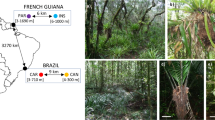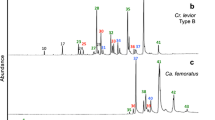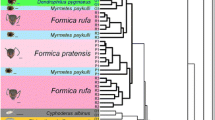Abstract
Social insects have a highly developed nestmate and species recognition system that is quite effective at keeping out unwanted intruders. Rare cases of “parabiosis,” however, are known in some ants where two species apparently live peacefully alongside each other within the same nest. Here, we report on such an association between the tiny Afrotropical ant Strumigenys maynei and the large ant Platythyrea conradti. We demonstrated that both ants peacefully share the same arboreal nests in spite of the presence of clearly distinct nestmate recognition cues. Because of the large size differences, we hypothesized that each of the two species would benefit from specializing in carrying out particular tasks, in analogy to the size-related division of labor observed in species with size-polymorphic workers. In line with this theory, we found that the tiny ant S. maynei was highly efficient at nest defense against intranidal arthropods and alien ant intruders, whereas the large ant P. conradti was highly skilled in nest engineering. We argue that the described association is likely mutualistic, as P. conradti clearly benefited from the supreme defense capabilities of S. maynei, and that, conversely, S. maynei took advantage of small prey thriving in the organic nest material collected by P. conradti.
Significance statement
Associations between social insects are typically parasitic in nature. A few cases, however, are known of beneficial associations between social insects. Here, we report such a rare association between two Afrotropical species that share the same nest even though they lack matching colony odors. The large ant Platythyrea conradti benefited from the presence of Strumigenys maynei as this tiny, but highly aggressive, ant was much more efficient in attacking intranidal and extranidal enemies. S. maynei in turn took advantage of P. conradti as this ant constructs a unique nest which attracts suitable prey.




Similar content being viewed by others
References
Aitchison J (1986) The statistical analysis of compositional data. Chapman and Hall, London
Batchelor TP, Santini G, Briffa M (2012) Size distribution and battles in wood ants: group resource-holding potential is the sum of the individual parts. Anim Behav 83:111–117. doi:10.1016/j.anbehav.2011.10.014
Billick I, Carter C (2007) Testing the importance of the distribution of worker sizes to colony performance in the ant species Formica obscuripes Forel. Insect Soc 54:113–117. doi:10.1007/s00040-007-0918-9
Bolton B (1999) Ant genera of the tribe Dacetonini (Hymenoptera: Formicidae). J Nat Hist 33:1639–1689
Bolton B (2000) The ant tribe Dacetini. Memoirs of the American Entomological Institute 65:1–1028
Browne WJ, Subramanian SV, Jones K, Goldstein H (2005) Variance partitioning in multilevel logistics models with over-dispersion. J R Stat Soc A 168:599–613
Buschinger A (2009) Social parasitism among ants: a review (Hymenoptera: Formicidae). Myrmecological News 12:219–235
Davidson DW (1988) Ecological studies of neotropical ant gardens. Ecology 69:1138–1152
Dejean A (2011) Prey capture behavior in an arboreal african ponerine ant. PLoS One 6:e19837. doi:10.1371/journal.pone.0019837
Dixson DL, Hay ME (2012) Corals chemically cue mutualistic fishes to remove competing seaweeds. Science 338:804–807. doi:10.1126/science.1225748
Emery VJ, Tsutsui ND (2013) Recognition in a social symbiosis: chemical phenotypes and nestmate recognition behaviors of neotropical parabiotic ants. PLoS One. doi:10.1371/journal.pone.0056492
Herre EA, Knowlton N, Mueller UG, Rehner SA (1999) The evolution of mutualisms: exploring the paths between conflict and cooperation. Trends Ecol Evol 14:49–53. doi:10.1016/S0169-5347(98)01529-8
Hölldobler B, Wilson EO (1990) The ants. Harvard University Press Cambridge, Massachusetts
Jandt JM, Bengston S, Pinter-wollman N et al (2013) Behavioural syndromes and social insects: personality at multiple levels. Biol Rev 89:48–67. doi:10.1111/brv.12042
Kronauer DJC, Pierce NE (2011) Myrmecophiles. Curr Biol 21:208–209. doi:10.1016/j.cub.2011.01.050
Lamon B, Topoff H (1981) Avoiding predation by army ants: defensive behaviours of three ant species of the genus Camponotus. Anim Behav 29:1070–1081. doi:10.1016/S0003-3472(81)80060-7
Menzel F, Blüthgen N (2010) Parabiotic associations between tropical ants: equal partnership or parasitic exploitation? J Anim Ecol 79:71–81. doi:10.1111/j.1365-2656.2009.01628.x
Menzel F, Schmitt T (2012) Tolerance requires the right smell: first evidence for interspecific selection on chemical recognition cues. Evolution 66:896–904. doi:10.1111/j.1558-5646.2011.01489.x
Menzel F, Blüthgen N, Schmitt T (2008a) Tropical parabiotic ants: highly unusual cuticular substances and low interspecific discrimination. Front Zool 5:16. doi:10.1186/1742-9994-5-16
Menzel F, Linsenmair KE, Blüthgen N (2008b) Selective interspecific tolerance in tropical Crematogaster-Camponotus associations. Anim Behav 75:837–846. doi:10.1016/j.anbehav.2007.07.005
Menzel F, Schmitt T, Blüthgen N (2009) Intraspecific nestmate recognition in two parabiotic ant species: acquired recognition cues and low inter-colony discrimination. Insect Soc 56:251–260. doi:10.1007/s00040-009-0018-0
Menzel F, Blüthgen N, Tolasch T et al (2013) Crematoenones—a novel substance class exhibited by ants functions as appeasement signal. Front Zool 10:32. doi:10.1186/1742-9994-10-32
Menzel F, Kriesell H, Witte V (2014) Parabiotic ants: the costs and benefits of symbiosis. Ecol Entomol 39:436–444. doi:10.1111/een.12116
Modlmeier AP, Foitzik S (2011) Productivity increases with variation in aggression among group members in Temnothorax ants. Behav Ecol 22:1026–1032. doi:10.1093/beheco/arr086
Molet M, Peeters C (2006) Evolution of wingless reproductives in ants: weakly specialized ergatoid queen instead of gamergates in Platythyrea conradti. Insect Soc 53:177–182. doi:10.1007/s00040-005-0856-3
Orivel J, Dejean A (1997) Ant gardens: interspecific recognition in parabiotic ant species. Behav Ecol Sociobiol 40:87–93. doi:10.1007/s002650050319
Oster GF, Wilson EO (1978) Caste and ecology in the social insects. Princeton University Press, NJ. Princeton.
Parmentier T, Dekoninck W, Wenseleers T (2015) Context-dependent specialization in colony defence in the red wood ant Formica rufa. Anim Behav 103:161–167. doi:10.1016/j.anbehav.2015.02.023
Parmentier T, Bouillon S, Dekoninck W, Wenseleers T (2016) Trophic interactions in an ant nest microcosm: a combined experimental and stable isotope (δ13C/δ15N) approach. Oikos 125:1182–1192. doi: 10.1111/oik.02991
Tian L, Zhou X (2014) The soldiers in societies: defense, regulation, and evolution. Int J Biol Sci 10:296–308. doi:10.7150/ijbs.6847
van Zweden JS, d’Ettorre P (2010) Nestmate recognition in social insects and the role of hydrocarbons. In: Blomquist GJ, Bagnères A-G (eds) Insect hydrocarbons: biology, biochemistry, and chemical ecology. Cambridge University Press, Cambridge, pp 222–243
Vantaux A, Dejean A, Dor A, Orivel J (2007) Parasitism versus mutualism in the ant-garden parabiosis between Camponotus femoratus and Crematogaster levior. Insect Soc 54:95–99. doi:10.1007/s00040-007-0914-0
Yéo K, Molet M, Peeters C (2006) When David and Goliath share a home: compound nesting of Pyramica and Platythyrea ants. Insect Soc 53:435–438. doi:10.1007/s00040-005-0890-9
Acknowledgements
This research was supported by a type II grant of the Belgian Focal Point of the Global taxonomy Initiative, by a grant from the FWO Vlaanderen (Research Foundation Flanders) to TP (grant nr. 11D6414N) and by the Centre of Excellence grant PF/10/07-SEEDS. Field work and aggression experiments were done during the Ant and Bee course at Lamto. We would like to thank Sébastien Kouamé Kan Loukou, Nangounon Soro and Nanga Yeo for their assistance in the field and with their help in conducting preliminary experiments and Ricardo Caliari Oliveira for his assistance with the GCMS analysis. We are very grateful for the identification of the myrmecophile species by the following experts: Rafael Molero Baltanás (Thysanura), Frans Janssens (Collembola), Paweł Jałoszyński (Scydmaeninae), Volker Brachat (Pselaphinae) and Tim Struyve (Staphylinidae).
Author information
Authors and Affiliations
Corresponding author
Additional information
Communicated by W. Hughes
Electronic supplementary material
Table S1
(PDF 155 kb)
Video S1.
P. conradti vs. S. maynei (MP4 5233 kb)
Video S2.
P. conradti vs. Crematogaster sp. 1 (MP4 2675 kb)
Video S3.
P. conradti vs. Tetramorium sp. (MP4 4347 kb)
Video S4.
S. maynei vs. Crematogaster sp. 2 (MP4 1882 kb)
Video S5.
S. maynei vs. Monomorium pharaonis (MP4 1430 kb)
Video S6.
S. maynei vs. Tetramorium sp. (MP4 1027 kb)
Video S7.
S. maynei vs. Neoasterolepisma delamarei (MP4 1639 kb)
Video S8.
S. maynei and P. conradti vs. Pselaphinae sp. 1 (MP4 2299 kb)
Video S9.
Inside view of the parabiotic nest after removal of organic material. Hundreds of Cyphoderus subsimilis and workers of P. conradti and S. maynei can be observed. (MP4 8594 kb)
Rights and permissions
About this article
Cite this article
Parmentier, T., Yéo, K., Dekoninck, W. et al. An apparent mutualism between Afrotropical ant species sharing the same nest. Behav Ecol Sociobiol 71, 46 (2017). https://doi.org/10.1007/s00265-017-2274-8
Received:
Revised:
Accepted:
Published:
DOI: https://doi.org/10.1007/s00265-017-2274-8




